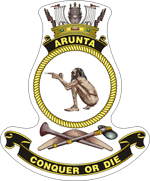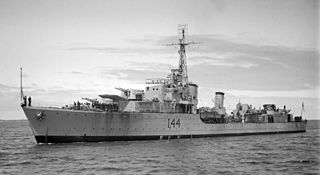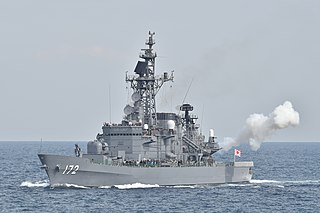Wollunqua, also written Wollunka or Wollunkua, is a snake-god of rain and fertility in Australian Aboriginal mythology of the Warramunga people of the Northern Territory of Australia, a variation of the "Rainbow Serpent" present in the mythology of many other Aboriginal Australian peoples. The snake, which emerged from a watering hole called Kadjinara in the Murchison Ranges, is said to be many miles long. When speaking of the Wollunqua snake in public, the name urkulu nappaurinnia is used, because if they were to call it too often by its real name they would lose control and it would come out and devour them all. It can place the rainbow in the sky at will.
Two ships of the Royal Australian Navy have been named HMAS Warramunga, after the Warumungu Aborigines.

The RIM-162 Evolved SeaSparrow Missile (ESSM) is a development of the RIM-7 Sea Sparrow missile used to protect ships from attacking missiles and aircraft. ESSM is designed to counter supersonic maneuvering anti-ship missiles. ESSM also has the ability to be "quad-packed" in the Mark 41 Vertical Launch System, allowing up to four ESSMs to be carried in a single cell.

HMAS Arunta (I30/D5/D130) was a Tribal-class destroyer of the Royal Australian Navy (RAN). Named for the Arrernte Aboriginal peoples, the destroyer was laid down in 1939 and commissioned into the RAN in 1942.

HMAS Warramunga is an Anzac-class frigate of the Royal Australian Navy (RAN). One of ten frigates built for the Australian and New Zealand navies, Warramunga was laid down by Tenix Defence in 1997 and commissioned in 2001. During her career, the frigate has operated in the Persian Gulf as part of Operation Catalyst, and undertaken anti-piracy operations off Somalia. Warramunga underwent the Anti-Ship Missile Defence (ASMD) upgrade during 2014. She is active as of October 2022.

HMAS Warramunga (I44/D123) was a Tribal-class destroyer of the Royal Australian Navy (RAN). Built during World War II, the destroyer entered service in late 1942. She was initially assigned to convoy escort duties, but was assigned to the joint Australian-American Task Force 74 in 1943, and was involved in supporting numerous amphibious landings through the South-east Asian region until the end of the war. From 1950 and 1952, Warramunga fought in the Korean War, then was converted into an anti-submarine destroyer. Returning to service in 1954, the destroyer was one of the first RAN ships to operate with the Far East Strategic Reserve, and undertook two tours with the organisation before she was decommissioned in 1959 and sold for ship breaking in 1963.
Operation Relex is the name given to the Australian Defence Force (ADF) border protection operation in the country's northern approaches conducted between 2001 and 2006. The operation was instigated following the Tampa affair in September 2001 and the Australian government's resultant Pacific Solution. The focus of Operation Relex was illegal immigration, with assets from all three services of the ADF deployed to prevent the arrival of Suspected Illegal Entry Vessels (SIEVs) in the Australian migration zone.

USS Brooks (DD-232/APD-10) was a Clemson-class United States Navy destroyer who served primarily in Europe and the Atlantic, the Adriatic, and both the Pacific and Caribbean after WWI. Between 1931 and 1939 she was placed out of commission. She was recommissioned in 1939 and served in the Atlantic until 1941, switching to the Pacific Theatre during World War II where she was badly damaged at the Battle of Lingayen Gulf in January 1945. She was named for Lieutenant John Brooks, Jr.
Warrant Officer of the Navy (WO-N) is the most senior sailor in the Royal Australian Navy (RAN). It is a singular appointment, being only held by one person at any time. The special insignia for the WO-N is the Australian coat of arms with a wreath around it. The current Warrant Officer of the Navy is Deb Butterworth.
The Warumungu are a group of Aboriginal Australians of the Northern Territory. Today, Warumungu are mainly concentrated in the region of Tennant Creek and Alice Springs.

The Warumungu language is spoken by the Warumungu people in Australia's Northern Territory. In addition to spoken language, the Warumungu have a highly developed sign language.

Rear Admiral Otto Humphrey Becher, & Bar was a senior officer in the Royal Australian Navy (RAN). Born in Harvey, Western Australia, Becher entered the Royal Australian Naval College in 1922. After graduating in 1926, he was posted to a series of staff and training positions prior to specialising in gunnery.

The order of battle of Australian forces during the Korean War consisted of one, and later two infantry battalions, naval forces of one aircraft carrier, two destroyers, and one frigate, as well as air forces consisting of one fighter squadron and one transport squadron. The first forces were committed in July 1950 from units based in Japan as part of the British Commonwealth Occupation Force, with Australia being the first UN member nation after the United States to commit elements from all three services. A total of 17,808 Australians served during the Korean War, including 1,193 members of the Royal Australian Air Force (RAAF), 5,771 from the Royal Australian Navy (RAN), and 10,844 from the Australian Army, with casualties including 341 killed and 1,216 wounded. Australian forces remained following the end of hostilities, with the last units finally departing in 1956.
The Esther Williams Trophy is one of two trophies that have circulated among ships of various navies, after originating in the Royal Australian Navy (RAN). Initially, in 1943, the trophy was a joke between two friends, Lieutenants Lindsay Brand and David Stevenson, serving in HMAS Nepal, an N-class destroyer attached to the British Eastern Fleet. Stevenson wrote on a photograph of Esther Williams, "To my own Georgie, with all my love and a passionate kiss, Esther"; Brand put the screen idol over his bed. The photo was taken to another ship by a fellow officer, and the "trophy" was then circulated by officers among some 200 other ships including in United States Navy, Royal Navy, and Royal Canadian Navy ships in Asian waters.
Vice Admiral Sir Wilfred Hastings "Arch" Harrington was a senior officer in the Royal Australian Navy (RAN), who served as First Naval Member and Chief of the Naval Staff from 1962 to 1965.
Gordon Francis Stirling was an Australian politician. He was the Labor member for Williamstown in the Victorian Legislative Assembly from 1973 to 1988.
The Malayan Emergency was a guerrilla war fought between Commonwealth armed forces and the Malayan National Liberation Army (MNLA), the military arm of the Malayan Communist Party, from 1948 to 1960 in Malaya. Australia's commitment to the emergency lasted 13 years, between 1950 and 1963, with army, air force and naval units serving. The Malayan Emergency was the longest continuous military commitment in Australia's history. Thirty-nine Australians were killed and 27 wounded.

Morabidae is a family of grasshoppers in the order Orthoptera. There are more than 40 genera and 120 described species in Morabidae, found in Australasia.

JS Shimakaze (DDG-172) is the second ship of the Hatakaze-class guided missile destroyers built for the Japan Maritime Self-Defense Force (JMSDF).









